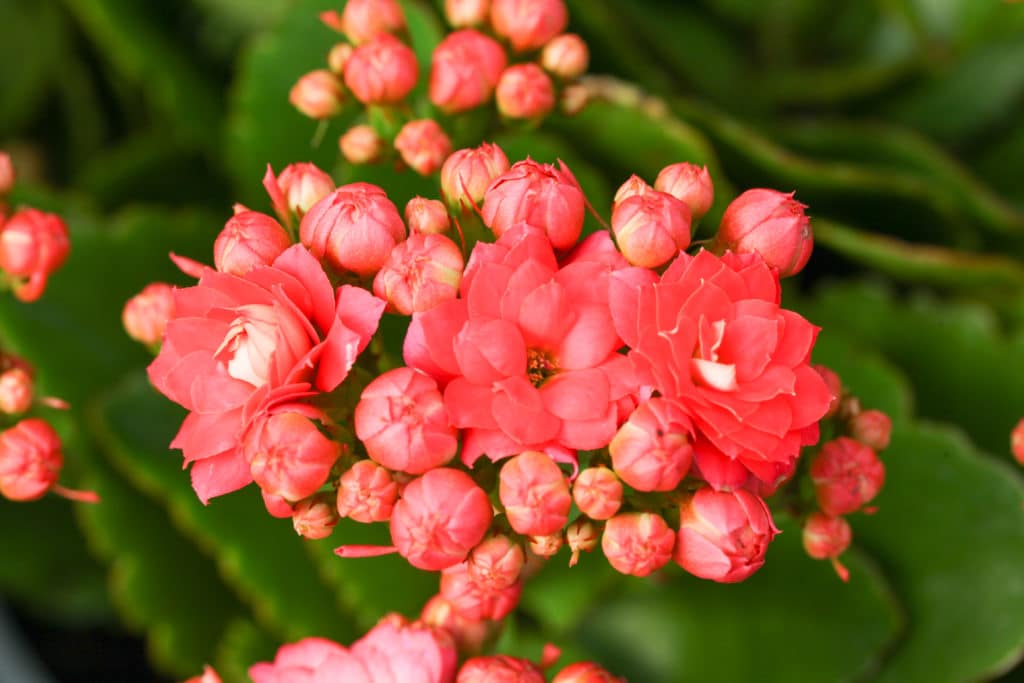
Kalanchoe blossfeldiana is a flowering succulent plant that comes in many varieties. It also goes by the name of Calandiva and Flaming Katy.
The Calandiva kalanchoe has been around for a while, but it was first introduced to the public as a cultivar (variety) of Kalanchoe blossfeldiana in 2003.
Calandiva care includes how to water it, what to fertilize it with and when, and questions about pests or diseases you may encounter along the way.
The Calandiva kalanchoe plant makes a wonderful houseplant that will brighten up any room with its beautiful blooms through the winter months when not much else is growing outside.
They’re also relatively low maintenance so they should do well indoors as long as you give them proper calandiva care!
Calandiva Care Tips
The Calandiva plant has a long bloom time that typically lasts for six to eight weeks. During this time, it will produce beautiful blooms in shades of pink, red, orange, and yellow.
Size:
The Calandiva plant is a small houseplant that can reach heights of up to 30cm and widths of 15 cm.
Temperature:
The Calandiva thrives in cool temperatures ranging from about 12°C (54 °F) to 18°C (64 °F). Temperatures higher than 24°C (75 °F), however, will slow down their growth significantly.
Light:
Calandivas need light but not direct sunlight unless you want them to bloom all at once! Keep it by the window or under fluorescent lights if this is your desire. If you grow it indoors with natural light, try placing it on a south-facing windowsill where they’ll get indirect sun for most hours of the day.
Watering:
The Calandiva should be watered thoroughly when the top of the soil feels dry to touch. Be sure not to overwater, as this will cause the roots to rot.
Fertilizing:
Fertilize your Calandiva plant every two weeks with a balanced liquid fertilizer diluted to half-strength while it is in bloom. Stop fertilizing once blooming has stopped.
Make sure you don’t use fertilizer containing high levels of nitrogen as this may damage the roots of Calandivas or, at worst, kill them!
You want to choose something higher in phosphorus instead. Always read instructions before applying any fertilizers – different plants have different requirements after all!
Pests and Diseases:
Spider mites are one possible pest you may encounter when caring for a Calandiva kalanchoe plant, but they can be treated with an insecticidal soap spray.
Crown rot is another possibility and can be caused by overwatering or poor drainage – symptoms include wilting leaves and browning and decay at the base of Calandiva plant.
Soil:
Kalanchoe calandiva can be grown in a potting mix that drains well. Try mixing equal parts peat moss and perlite together with your Calandiva plant’s soil for optimal drainage.
Pruning:
It’s not necessary to prune Calandivas but if you want to do it, be sure to wait until after their bloom cycle is finished so as not to interrupt the plant’s blooming. Pruning Calandiva plants can promote further flowering and growth though!
Propagation:
Kalanchoe calandiva can be propagated by cuttings taken from the stems of young plants if desired. You want to take your cutting just below a node where there are two leaves still attached.
After taking this cutting, let it dry out for 24 hours before you place it in some moistened perlite or vermiculite to root.
Keep temperatures about 21°C (70 °F) and humidity between 75-80% until new growth emerges.

Summary
If you enjoy caring for Kalenchoe blossfeldiana cultivars like Calandiva, consider growing other types too such as ‘Fangcun Sunshine’ or even some hybrids like ‘Coral Sun’.
In order to get the most out of your Calandiva plant, you should water it regularly and fertilize it with a portion of balanced, slow-release plant food.
You may also want to consider using a pot with drainage holes and adding sand or gravel to the bottom of the pot to help keep the soil from washing away.
If you encounter any pests or diseases while caring for your Calandiva, be sure to take action immediately. Common problems include mealybugs, spider mites, aphids, and whiteflies.
With early detection and treatment, most of these issues can be resolved fairly easily.
